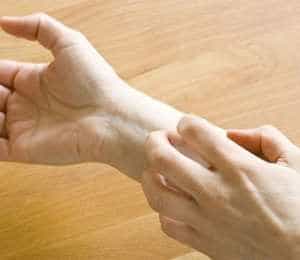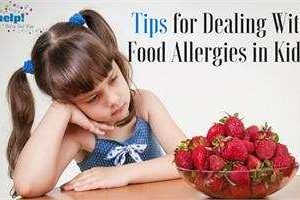1. What Are Allergies?
The immune system protects us from harmful substances such as viruses and bacteria. An allergy is a type of strong immune response to a substance that is not harmful to most people. This substance is known as an allergen.
For children with an allergy, the body’s immune system overreacts and treats the allergen as an invader. This results in symptoms from mild discomfort to severe distress.
Allergic disorders, including food allergies, are common in childhood. Far more people have a food intolerance. A food intolerance is an unpleasant symptom triggered by food. It does not involve the immune system. Many children with allergies also have asthma.
2. Types of Allergens
Common Airborne Allergens
Dust mites are common airborne allergens. These tiny bugs live in warm, damp, dusty places in your home. They eat dead skin cells. Their waste is a major cause of allergies and asthma. Other common airborne allergens include:
- pollen from flowers and other plants
- mould
- pet dander (dead skin cells)
- cockroaches
Common Food Allergens
The most common food allergens include:
- peanuts
- tree nuts such as hazelnuts, walnuts, almonds, and cashews
- eggs
- cow’s milk
- fish, crustaceans, and mollusks
Even small amounts of these foods can trigger anaphylaxis (anna-fil-AX-iss) in some allergic children. Allergens can also be hidden in common party dishes like cookies, cakes, candies, or other foods, so always ask the cook or host if dishes contain foods your child is allergic to.
Other Common Allergens
- insect stings
- medicines
- chemicals
3. Signs and Symptoms of Allergies
Allergic reactions will vary in severity from allergy to allergy and child to child. Where you live can also affect the type and severity of the allergy. Your child’s allergic reaction depends on which part of the body was exposed to the allergen. Most commonly, allergic reactions affect a child’s eyes, nose, throat, lungs and/or skin.
Allergy symptoms may include:
- breathing problems
- burning, tearing, or itchy eyes
- conjunctivitis (red, swollen eyes)
- coughing
- hives (raised, red, itchy bumps)
- itching of the nose, mouth, throat, skin, or any other area
- runny nose
- skin rashes
- wheezing
- swelling around the face or throat
Airborne Allergens
Airborne allergens usually cause sneezing, itchy nose or throat, nasal congestion, red and itchy eyes, and coughing. Some children also have wheezing and shortness of breath.
Food Allergens and Insect Bites
Your child’s response to a food allergy or insect bite will depend on the degree of sensitivity to that food or bug. Symptoms can include:
- itchy mouth and throat when food is swallowed
- hives
- a rash that looks like eczema
- runny, itchy nose
- difficulty breathing
- swelling around the face or throat
- going into shock
4. What Causes Allergies?
Allergens may come in contact with the skin or be breathed in, eaten, or injected.
When the body detects an allergen, it signals the immune system to produce antibodies called immunoglobulin E (IgE). Those antibodies cause certain cells in the body to release chemicals called histamines. Histamines swim through the bloodstream to defend against the invading substance or allergen.
5. Anaphylaxis
Some allergies, in particular food allergies, can be severe and life-threatening. If the sensitivity to an allergen is extreme, your child may experience anaphylaxis within seconds of being exposed to the allergen.
Anaphylaxis is the body’s quick and strong defense in response to the allergen. This response can be so strong it can be dangerous. The antibodies released during anaphylaxis may cause difficulty breathing, swelling, or a drop in blood pressure (shock).
Fast treatment with a medicine called epinephrine (epp-in-EFF-rin) can stop this process and save your child’s life. This medicine is commonly known as the Epi-pen. Anaphylaxis is an emergency. Your child needs to go to a hospital right away.
6. Getting Diagnosed
In order to determine your child’s allergy, your child’s doctor will usually do a physical exam of your child. The health provider will then ask for your child’s allergy history, and ask for a description of the allergic symptoms. Your child might then be tested. The tests may include skin tests, blood tests, a chest X-ray, a lung function test, or an exercise tolerance test. The doctor will make a diagnosis based on the test findings. Then the doctor will meet with you and your child at a later date to discuss the findings.
Preparing for Your Appointment
Your child may need to stop using medication for a certain amount of time before the allergy test. These medications may include antihistamines and other pills for motion sickness. Ask your doctor if your child should stop taking medications before the visit.
7. What to Do at Home
Treat your child’s allergy with the medicine advised by your child’s doctor. If your child has a rash, calamine lotion or cold compresses may relieve the pain and irritation. Antihistamines (such as Benadryl or Chlor-tripolon) can also relieve the pain or itching. However, these medicines may cause your child to become sleepy.
If your child has a severe allergy, your doctor might give you a prescription for an epinephrine self-injection pen (Epi-pen). Your doctor can show you how and when to use the pen. You or your child may need to carry one at all times.
As much as possible, reduce your child’s contact with allergens. The steps you take depends on what your child is allergic to. Discuss this with your child’s doctor.
Airborne Allergens
Some options for reducing your child’s contact with airborne allergens include:
- Having a pet-free home or, if you have a pet, keeping it out of the child’s room and bathing it regularly.
- Removing carpets and rugs from the home, especially from your child’s bedroom. Hard floor surfaces do not collect dust as much as carpets do.
- Reducing the relative humidity in the home.
- Washing bedding in hot water. This will help reduce dust mites.
- Controlling contact with outdoor pollen by closing windows in peak seasons. Use an air conditioning system with a small-particle filter.
- Getting rid of items in the home that collect dust, such as drapes or old, unclean furniture.
- Cleaning your home often, particularly sweeping or vaccuming the floor in bedrooms, where your child changes, and where much of their skin cells may be.
- Sealing pillows and mattresses if your child is allergic to dust mites. Many stores sell pillow and mattress covers that prevent allergens that can irritate your child when they sleep.
- Keeping bathrooms and other mould-prone areas clean and dry.
Food Allergies
If your child has a food allergy, teach your child to be aware of the foods to avoid. You and your child should learn to read labels and ask questions about served food. It is also important to inform all teachers, family, friends and caregivers of your child’s allergy and any restrictions on your child’s diet.
8. A Word About Infants
If there is a family history of eczema and allergies in a parent or sibling, discuss infant feeding with your child’s doctor.
9. When to Seek Medical Assistance
Take your child to the nearest Emergency Department if your child has any of the following:
- trouble breathing
- swelling, particularly of the face, throat, lips, and tongue
- rapid drop in blood pressure
- dizziness
- loss of consciousness
- hives
- tightness of the throat
- hoarse voice
- lightheadedness
- received epinephrine, since the symptoms can start again hours after the epinephrine is given
PHOTOS: MELALOUISE/FLICKR CC, FIMBRETHIL/FLICKR CC, ANJANETTEW/FLICKR CC
Republished with permission from AboutKidsHealth.ca. Originally published by Help! We’ve Got Kids in March 2010.
READ MORE LIKE THIS:
Being enrolled in a summer camp may be more beneficial to your kids than you think. Take a look at how camp improves kids’ self-esteem.
Here are 9 kid-friendly recipes featuring some locally-grown vegetables that are sure to impress little tastebuds.
With summer heating up and air-conditioning being expensive, go out and watch one of these 8 movies to see with your kids this summer in an air-conditioned theatre.
Sign up for our newsletters to get the latest articles delivered to you!




